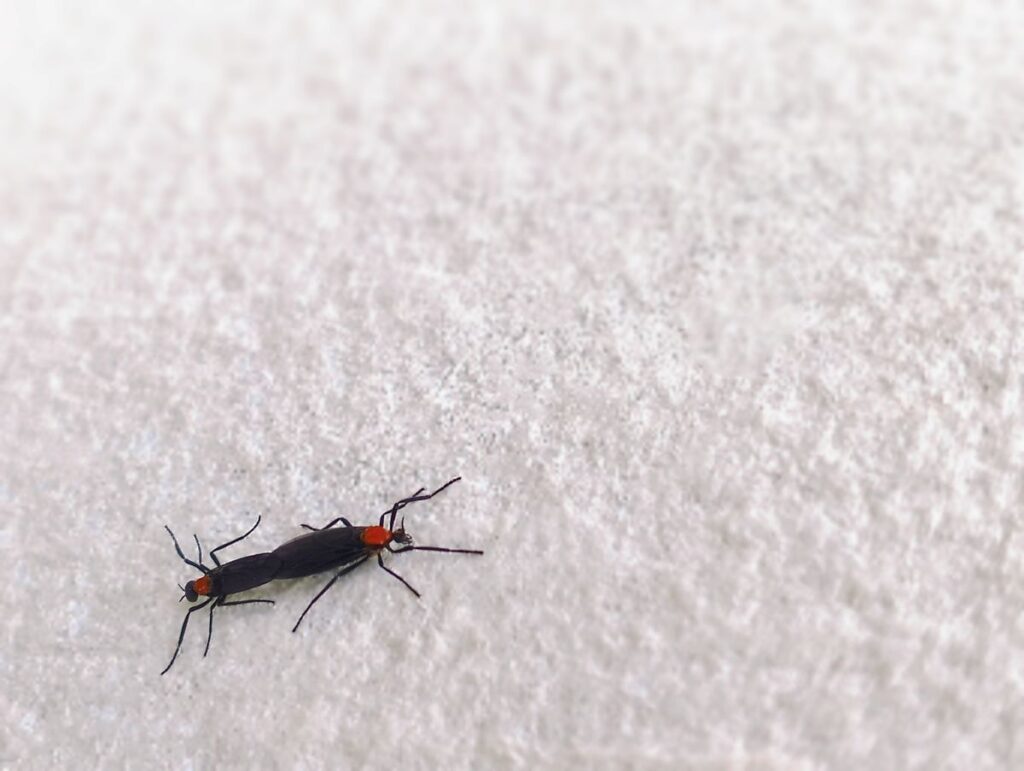Lovebugs, Plecia nearctica, are small, black insects with a red thorax (the area behind the head) are more correctly called March flies. Even though they occur in May and Sept. in Texas.
They are classified in the insect order Diptera (true flies) and technically are not bugs, being more closely related to the house fly. Lovebugs belong to the insect family Bibionidae (March flies). Every few years a massive emergence of lovebugs is likely to occur. Making driving the highways of southeast Texas in May or Sept. an unpleasant experience.
Lovebugs, also known as honeymoon flies, are named for their habit of mating while in flight. Lovebugs occur from Central America to Texas and along the Gulf Coastal Plain to Florida. They also occur in Georgia and South Carolina along the Atlantic coast.
Lifecycle
There are two lovebug generations per year in Texas with adults usually emerging in May and Sept. The emergence period lasts about four weeks while the adult flies live only three to five days.
At first, there are just a few flies present, but populations rapidly increase, peaking at two weeks and then declining. Due to natural population cycles, massive outbreaks of lovebugs do not occur every year.
Lovebugs use their olfactory senses to locate decaying vegetation where they lay their eggs. Researchers have discovered that lovebugs are attracted to the odor of vehicle exhaust that has been exposed to sunlight (ultraviolet light). Apparently certain chemicals in vehicle exhaust are the same as chemicals produced by decaying vegetation. This may be why lovebugs seem concentrated along well-traveled highways.
They are also visually attracted to light colored objects, especially white. The flies are most active between about 9:00 a.m. and 5:00 p.m. They are not active at night and are not attracted to electric lights.
Impacts
Even though they don’t bite or sting, lovebugs are considered a nuisance, especially to motorists. After a mass emergence, vehicles may have so many lovebugs splattered on the windshield that the driver cannot see.
They can also clog vehicle radiators causing engines to overheat and can cause cooling units of refrigerated vans to malfunction. The slightly acidic body fluids of smashed lovebugs will damage paint on vehicles if not removed within a few days.
Even though lovebugs are considered a general nuisance, they do perform some beneficial functions. The adults aid in pollination by feeding on the nectar and pollen of flowers. Female lovebugs lay their eggs (100-300 per female) in decaying leaves and grass on the ground and the larvae feed on this material, helping it to decompose and be recycled.
Control
Lovebug adults don’t have any significant natural enemies (except maybe cars and trucks). Birds, toads, frogs, lizards, and other insects do not feed on them and few parasites are known.
Neither the larvae nor the adults are notably affected by diseases such as bacteria, fungus, or virus. Natural controls, primarily weather, have the greatest effect on lovebug populations. Cold winters and dry weather will kill many of the larvae.
Although adult lovebugs have no known natural enemies, the larvae are a source of food for some birds and insects. Spiders may be a natural enemy of lovebugs as spider webs loaded with adult lovebugs have been observed. Insect-eating pitcher plants full of adult lovebugs have been found, but the lovebugs were toxic to the plant.
Certain insecticides are effective in controlling lovebugs, but using insecticides is impractical when populations are high because the adults are so short-lived and occur over a large area. Unfortunately, when outbreaks occur, people are forced to tolerate the flies until they have run their course.
